|
|
|
|
|
|
|
|
|
|
|
|
| Downy mildew: | |
| Downy mildew, caused by the oomycete Peronospora effusa (syn. P. farinosa f. sp. spinaciae, Pfs) (Brandenberger et al. 1994;
Correll et al. 2011), is the most economically important disease of spinach. Currently, 19 races of Pfs (Pe:1 to Pe:19) have been reported (Cornell et al. 2021; Feng et al. 2018a,
2020; Ribera et al. 2020, 2021; Smilde et al. 2021). The ability of the pathogen to overcome host resistance is a particular concern, as genetic resistance is the primary management
tool for downy mildew (Correll et al. 1994, 2011; Kandel et al. 2019; Morelock and Correll 2008). Currently, 13 resistance loci have been described and a series of resistant spinach
lines, each with one or two resistance loci, has been developed (Dijkstra 2015a, b, 2016; Ribera et al. 2020, 2021) and mapped (Feng et al. 2018b; Bhattarai et al. 2020a, 2021, 2023;
She et al. 2018). Unfortunately, a new race, Pe:19, has emerged that can overcome the resistance gene in the cv. Hydrus (RPF11), which is resistant to races Pe:1 to Pe:19, causing
R-gene breakdown (Correll et al., 2021; Feng et al. 2020; Ribera et al. 2020, Smilde et al., 2021). So far, no single gene has been able to provide resistance to all known races in
spinach production. Because new races of the downy mildew pathogen have been regularly emerging (Feng et al. 2014, 2018, 2020; Ribera et al. 2020), the use of broad QTL for downy
mildew resistance is an alternative approach for disease management. Field tolerance to downy mildew has been studied in multiple commercial spinach-producing regions and genome-wide
association studies (GWAS) have identified field tolerance associated single nucleotide polymorphism (SNP) markers in respective environments and prospects of genomic selection (GS)
using multiple genomic prediction (GP) models have been reported (Bhattarai et al. 2020b, 2022a). The ideal strategy may involve introgressing a combination of major genes and QTL in
commercial spinach cultivars to achieve durable resistance against downy mildew (Bhattarai and Shi, 2021; Bhattarai et al. 2022a). |
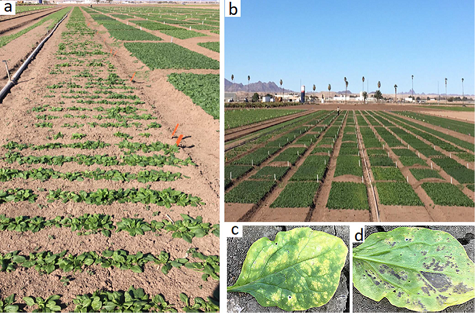 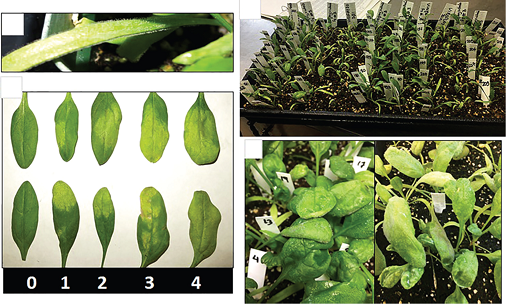 |
| Although a specific economic analysis of disease pressure is not available, the impact of diseases, particularly downy mildew, has been
the focus of two emergency symposia in Yuma, AZ and Salinas, CA. In the past ten years, based on grower input through the California Leafy Greens Board and the California Seed Association,
between 30-70% of organic production fields are being destroyed due to mildew pressure. In addition, large labor crews are being employed (see left Figure) to cull out leaves with downy
mildew symptoms to prevent the crop from being downgraded for quality. |
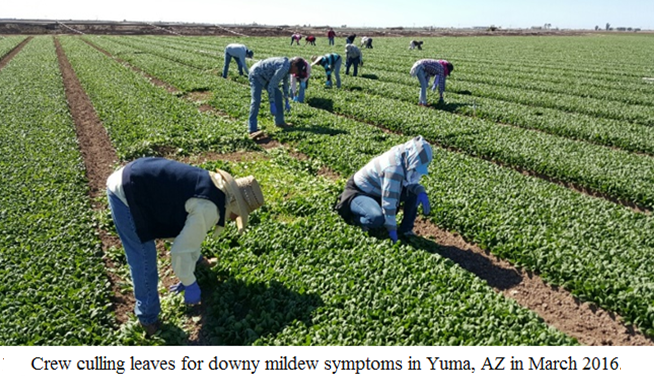 |
| White rust: | |
| White rust, caused by Albugo occidentalis, is an oomycete obligate pathogen that can cause severe yield losses (Brandenberger et al. 1994;
Correll et al. 2011). As a result of previous efforts, our team conducted genome-wide association studies (GWAS) for white rust resistance with 346 USDA spinach accessions in the
previous SCRI project and identified nine markers located on chromosomes 2, 3, 4, and 6 associated with white rust resistance using different GWAS models (Shi et al. 2022). The results
indicated that GWAS-derived significant single nucleotide polymorphism (SNP) markers increased prediction accuracy with an r-value =0.84. These SNP markers and high prediction accuracy
provide valuable information for breeders to improve spinach by marker-assisted selection (MAS) and genomic selection (GS) (Shi et al. 2022). Furthermore, Avila’s lab (Co-PI) identified
448 minor alleles associated with white rust susceptibility in spinach (Awika et al. 2019). Our results indicate that susceptibility is highly determined by disproportionate
over-representation of minor alleles, which could be used to select more resistant plants. However, validation is required to routinely implement identified markers in spinach breeding
programs. |
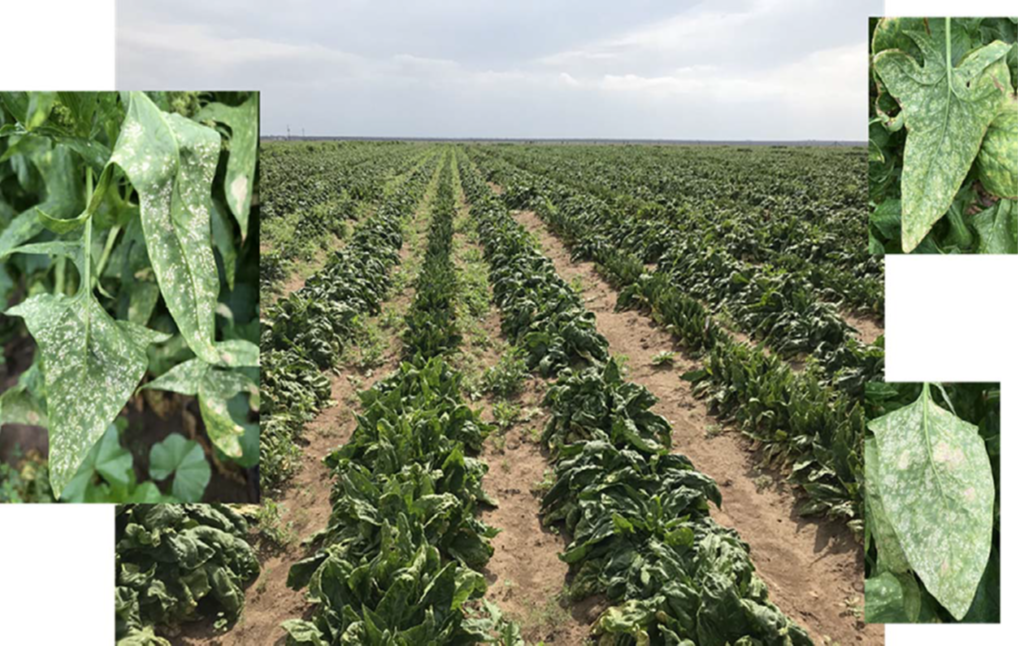
|
| Fusarium wilt: | |
| Fusarium wilt, caused by Fusarium oxysporum f. sp. spinaciae, is a major disease in some regions of spinach production and poses a
serious problem, specially in spinach seed production (Correll et al. 1994; Horinouchi et al. 2010). FW of spinach is an increasingly important disease in California and Washington.
Unfortunately, no major genes for resistance to FW have been identified (Laguna 2000). Neverless, multigenic resistance has been identified by du Toit’s and Correll’s labs (Co-PIs) and
several populations of FW resistant x susceptible accessions have been developed for QTL mapping and GWAS for SNP markers identification (Gyawali et al. 2019). The genomic resources
available for both the host (spinach) and the pathogen (F. oxysporum f. sp. Spinaciae) can be used for mapping host resistance, pathogen virulence genes, and host-pathogen interactions
using simultaneous QTL analysis. In addition, we have identified novel FW resistance sources in S. turkestanica accessions, a wild spinach relative (Gyawali et al. 2021). However, these
resistance genes need to be introgressed into cultivated spinach to fully harness the benefits of the novel sources of resistance alleles. |
 
|
| Stemphylium leaf spot: | |
| Stemphylium leaf spot is caused by Stemphylium vesicarium and S. beticola (= S. botryosum; S. botryosum f. sp. spinacia
) (Liu et al. 2020). Recent surveys have showed that SLS is the predominant leaf spot in the USA (AZ, CA, SC, and TX) (Liu et al. 2020). Our team screened the USDA spinach collection
and commercial cultivars using an isolate of S. beticola and identified eight SNP markers associated with resistance (Mou et al. 2008a; Shi et al. 2016a). More recently, Correll and
Shi’s labs evaluated 316 USDA spinach accessions and 30 commercial cultivars for SLS resistance in a greenhouse using an S. vesicarium isolate from Yuma, AZ and found significant
differences in disease severity among the genotypes, with Arkansas lines AR08-03-316 and AR08-454 providing high resistance (Liu et al. 2020, 2021). Subsequent GWAS analyses have
identified SNP markers associated with SLS resistance (Bhattarai et al., 2020c; 2022b). Additionally, du Toit and Stein’s groups performed a field trial in Crystal City, TX in each of
the three years, and identified cultivars with excellent resistance to S. vesicarium (Spawton et al. 2020). It is thus necessary to evaluate spinach lines for SLS susceptibility at
different locations for multiple years to select germplasm with SLS resistance and identify molecular markers associated with resistance to the two SLS species. |
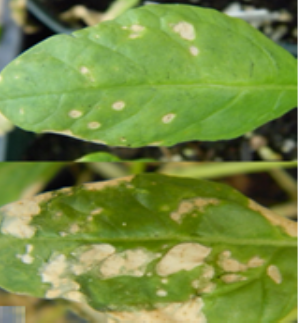 |
| Anthracnose leaf spot: | |
| Anthracnose leaf spot, caused by Colletotrichum spinaciae (C. dematium f. sp. spinaciae), is an important emerging disease of
spinach. In the absence of cultivars resistant to ALS and with poor efficacy of fungicides against this pathogen, areas of spinach production in the US have been experiencing more
frequent outbreaks of ALS, resulting in up to 100% yield losses in the Texas Wintergarden area (K. Cochran, personal communication, 2019). In preliminary work, Avila’s group (Co-PI)
screened a diverse collection of 276 spinach accessions for severity of anthracnose (Awika et al 2020). Only five (2%) accessions were highly resistant. In contrast, most accessions
were very susceptible (61%). Furthermore, GWAS identified 49 significantly associated markers for resistance distributed over several spinach chromosomes. The results indicate that
resistance to ALS is polygenic but additional testing in multiple locations and years is required to validate and implement the molecular markers for utilization in breeding programs.
|
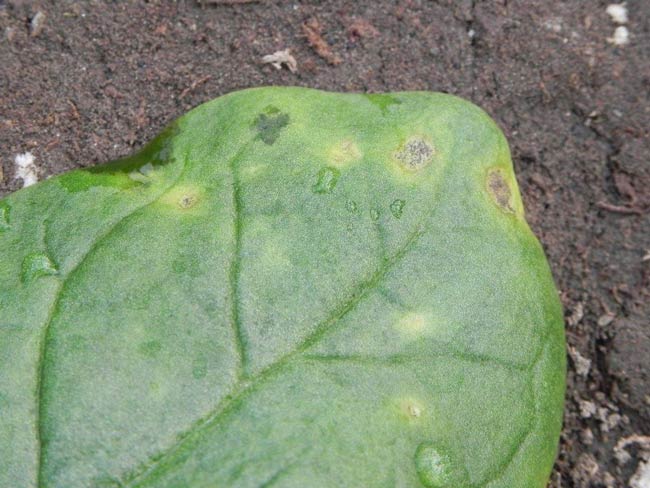 |
| Project References | |
| The Bibliography & References can be viewed or downloaded HERE! |